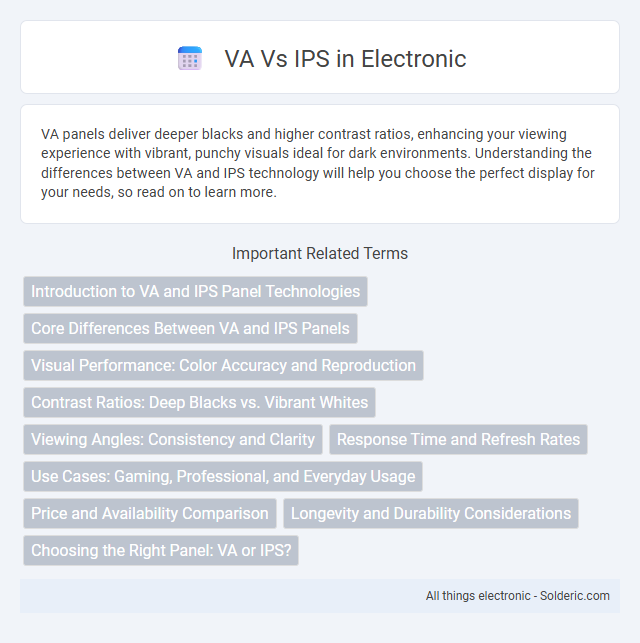VA panels deliver deeper blacks and higher contrast ratios, enhancing your viewing experience with vibrant, punchy visuals ideal for dark environments. Understanding the differences between VA and IPS technology will help you choose the perfect display for your needs, so read on to learn more.
Comparison Table
| Feature | VA (Vertical Alignment) | IPS (In-Plane Switching) |
|---|---|---|
| Contrast Ratio | High (typically 3000:1 to 6000:1) | Moderate (typically 1000:1 to 1300:1) |
| Color Accuracy | Good, but less vibrant | Excellent, better color reproduction |
| Viewing Angles | Narrower (typically 150deg horizontal/vertical) | Wide (up to 178deg horizontal/vertical) |
| Response Time | Slower (typical 4-8 ms) | Faster (typical 1-5 ms) |
| Black Levels | Deep blacks, better for dark scenes | Less deep blacks |
| Cost | Generally lower | Generally higher |
| Best Use Case | Movies, darker environments, high contrast needs | Photo editing, gaming, color-critical applications |
Introduction to VA and IPS Panel Technologies
VA (Vertical Alignment) and IPS (In-Plane Switching) are two prominent LCD panel technologies used in modern displays. VA panels excel in delivering higher contrast ratios and deeper blacks by aligning liquid crystals vertically when inactive, while IPS panels provide superior color accuracy and wider viewing angles through horizontal crystal alignment. Understanding these fundamental differences helps in selecting the right display technology for specific applications such as gaming, professional design, or general multimedia use.
Core Differences Between VA and IPS Panels
VA panels offer higher contrast ratios and deeper blacks due to vertically aligned liquid crystals, making them ideal for dark room viewing and cinematic experiences. IPS panels provide superior color accuracy, wider viewing angles, and faster response times, which benefit graphic design, professional photo editing, and competitive gaming. Your choice between VA and IPS should consider whether contrast or color fidelity is more critical for your specific visual needs.
Visual Performance: Color Accuracy and Reproduction
IPS panels deliver superior color accuracy and wider color gamut, making them ideal for tasks requiring precise color reproduction such as photo editing and graphic design. VA panels typically offer higher contrast ratios but exhibit less consistent color performance and narrower viewing angles, which can result in color shifting and diminished vibrancy. For applications prioritizing true-to-life colors and uniformity across viewing angles, IPS technology provides more reliable and vivid visual performance.
Contrast Ratios: Deep Blacks vs. Vibrant Whites
VA panels boast higher contrast ratios, delivering deeper blacks ideal for dark room viewing and enhancing shadow details in your content. IPS panels provide more vibrant whites and consistent color accuracy across wide viewing angles, making them perfect for color-critical tasks. Choosing between VA and IPS depends on whether you prioritize deep blacks or vibrant whites for your visual experience.
Viewing Angles: Consistency and Clarity
VA panels offer deep contrast and rich colors but can suffer from reduced viewing angles, leading to color shifting and decreased clarity when viewed from the side. IPS panels provide consistent color accuracy and clarity across wide viewing angles, ensuring your display maintains image quality even when viewed off-center. Choosing an IPS panel enhances your viewing experience by delivering reliable color and sharpness regardless of screen position.
Response Time and Refresh Rates
VA panels typically have slower response times, often ranging from 4 to 8 milliseconds, which can result in motion blur during fast-paced gaming or video playback. IPS panels generally offer faster response times, as low as 1 to 4 milliseconds, contributing to smoother motion clarity and reduced ghosting effects. Refresh rates for both VA and IPS displays vary widely, with high-end models supporting up to 240Hz or more, though IPS monitors are more commonly preferred for competitive gaming due to their superior response times and consistent color accuracy.
Use Cases: Gaming, Professional, and Everyday Usage
VA panels deliver higher contrast ratios ideal for immersive gaming and watching dark scenes, while IPS panels offer better color accuracy and wider viewing angles, making them preferred for professional photo and video editing. Everyday users benefit from IPS displays due to their vibrant colors and consistent image quality across multiple viewing positions. Your choice depends on whether gaming depth or color precision is the priority for your specific use case.
Price and Availability Comparison
VA panels generally offer a more budget-friendly option compared to IPS panels, making them popular for cost-conscious buyers seeking deeper contrast ratios. IPS panels tend to be priced higher due to their superior color accuracy and wider viewing angles, which also affects their availability in premium monitor and TV models. Retailers stock a broader range of VA displays across mid-range to budget segments, while IPS panels dominate high-end markets with limited but high-quality selections.
Longevity and Durability Considerations
VA panels generally offer better longevity and durability due to their simpler liquid crystal alignment, leading to less susceptibility to image retention and burn-in compared to IPS panels. IPS displays, while providing superior color accuracy and viewing angles, often experience faster wear in backlight performance and potential screen glow over extended use. When prioritizing long-term reliability, VA monitors typically maintain consistent performance and structural integrity over years of heavy usage.
Choosing the Right Panel: VA or IPS?
Choosing the right panel depends on your viewing needs; VA panels excel in contrast ratio and deeper blacks, making them ideal for watching movies in dark rooms. IPS panels offer superior color accuracy and wider viewing angles, perfect for graphic design and collaborative environments. Consider your usage context to determine if your priority is vibrant visuals or consistent colors from multiple angles.
VA vs IPS Infographic

 solderic.com
solderic.com